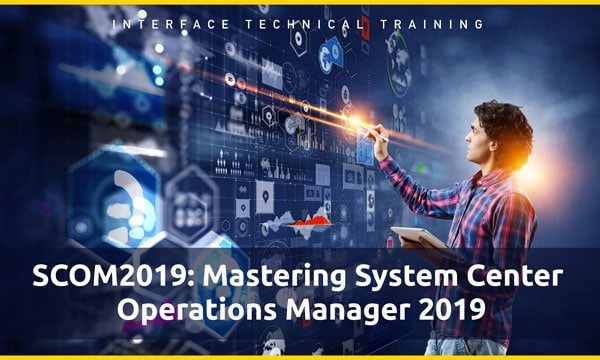
Overview
- Introduction to the SCOM Sizer
- How is SCOM used / Purpose of SCOM
- Architecture
- Terminology
- Services
- Naming Conventions
- Versioning and Good documentation behavior
Security
- Service Account Requirements
- Component Connectivity
Installation
- System Requirements
- Basic Installation
- Security
Install and configure HA (High Availability)
- HA for the Console, Web console, Report Services and PowerShell
- SQL Always ON technology
Install The Console
Install and configure the Web Console e.g. for a large screen display
Install Report Services
- Configure Reporting for SMTP, settings and controlling Rendering
- Upgrading from a distributed Operations Manager 2012 Management Group
- Using SSL/Https internally between users and the report/web services
- Management Group and Server Settings
- Notification, using Notification with PowerShell scripts
- Creating Subscribers and subscriptions
- RMS Emulation – why we need it and controlling it with PowerShell
- Agent Rollout, manually, automatically and the Auto Agent Assignment
- Agents, Gateways and Certificate authentication
- Use Resource Pools to control Management Server responsibility
- Monitoring Unix/Linux Servers with SCOM 1801
- User Interfaces, the new Widgets and presentation with SharePoint and Visio
- Creating MAP View with locations
- Reporting and the Data warehouse database, controlling the purging and logging
- Using SQL Profiler to check the traffic to/from the SQL server
- Creating own reports with Visual Studio
- APM (Application Performance Management), find bottlenecks in .net applications
- ACS (Audit Collector Services), a consolidated event auditor
- Network Monitoring, Discovery rules, views and using advanced port monitoring
- Management Packs, Creating with Visual Studio, Authoring tool , Visio and the console
- Putting it all together, creating a 360 service, multi-level topology monitoring and creating own Service/Distributed Application monitoring
- Monitoring SCVMM with SCOM 2019
- SCOM 1801 and Orchestrator – Interaction in both ways
- SCOM 1801 and Service Manager, creating Incident, Task and Connectors
- Non Microsoft Monitoring – Monitor anything – Check the coffee level
Management Packs
We are going through the different kind of objects contained in a Management Pack
Rules
- Monitors
- Attributes
- Groups
- Tasks
- Views
- Reports
- SCOM Advanced – Management Servers
- Introduction to the Communication in SCOM
- Configuring and optimizing the Management servers and agents
- Optimizing the database and data warehouse
- Defining and managing Resource Pools
- Integrate automatically configuration of agents AD Integration
Implement Intelligence in your Management Group
- With PowerShell
- Scripts
- Monitoring Application/Services
Management Packs
- Implement and document your Management Packs
- Implement Change management on you Management Packs
- Creating and Authoring own Management Packs
- Individual Management Packs objects
- Using Visual Studio to create Management Packs
- Using Authoring Console to create Management Packs
- Using Visio to Create Management Packs
User Interfaces
- Presenting Dashboards
- Creating Customize Dashboards
- Create your own widgets
- Use the Global Service Monitor
- Reports
Connecting Operations Manager
- Using an XML connector to communicate with SCOM
- Using Web Services to communicate with SCOM
- Connecting System Center with SCOM and the other way around
- Trap it – with mails, snmp or files
Linux Monitoring
- Installing Linux clients
- Creating monitors and rules against Linux
- Implementing Applications Server Monitoring
APM
- Implementing APM
- Server and Client Side Configuration
Network Monitoring
- Scale and implement
- Creating rules for your Devices and interfaces
- Creating own SNMP Traps
ACS (Audit Collector Services), a consolidated event auditor
- Install and configure ACS
Agentless Exception Monitoring
- Collect and present your organizations exceptions
This course is intended for Enterprise Systems Engineers, Administrators and System Integrators who need to implement Service Monitoring using System Center Operations Manager (SCOM).
Before attending this course, students must have:
- Experience with Windows Server 2012 R2/2016 Administration
- Basic understanding of Active Directory
- Basic understanding of Network communication
Its recommended that students have the following:
- An understanding of the System Center Suite is desirable, but not needed.
- Experience with earlier version of SCOM or other Monitoring Tools
- Virtualization Technologies: Hyper-V
- Basic Knowledge of PowerShell
- Knowledge of Cloud Topologies
After completing this course, you will be able to:
- Install and Configure SCOM on Windows Server 2016 and SQL Server 2012, Report Services and Web service.
- Describe and understand the logical architecture of an SCOM infrastructure
- Articulate the functions of the components and services in an SCOM infrastructure
- Troubleshoot issues with SCOM components and Agent Monitoring
- Design end-to-end monitoring of Services – Multi layered application design
- Working with SCOM in conjunction with other System Center products
- Use the Silverlight Web console
- Present your views in the Console, Web Silverlight console, Sharepoint as IFrames or as Web Parts.
- Working with Visio to present Services, Agents and classes you design.
- Create Management Packs with the console, the authoring console, Visio and Visual Studio.
- Using PowerShell to get information about the SCOM environment
- Describe and understand the logical architecture of an SCOM infrastructure
- Configuring a distributed SCOM installation and defining resource pools
- Modeling Applications in a way so it will be possible to monitor each layer
- Deciding the best Authoring solution and using the correct type of monitoringobject
- Defining and using different tools to Create Management Packs
- Going through all Monitoring objects with real world samples
- Digging into the Data warehouse database and using the aggregated tables for reporting.
- Troubleshooting issues with SCOM components and Agent Monitoring
- Design and creating end-to-end monitoring of Services – Multi layered application design
- Creating and Using Web Services to communicate with other Monitoring Targets
- Creating and using your own XML connector to communicate with Helpdesk systems
- Using Powershell to create scripts and get information about the SCOM environment
- Update Alerts, Create Tasks and perform scripted intelligence in SCOM 2019
